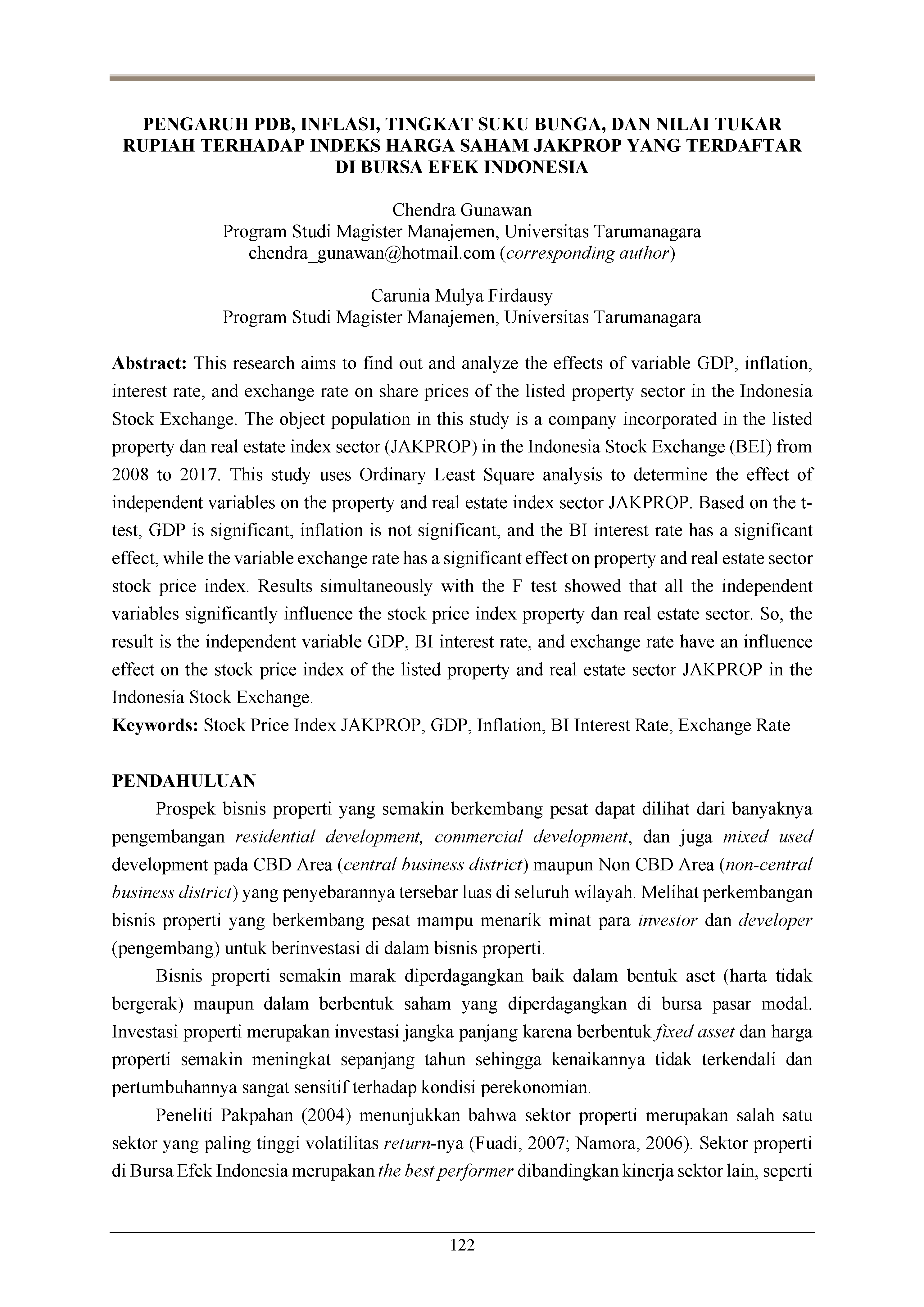Pengaruh PDB, inflasi, tingkat suku bunga, dan nilai tukar Rupiah terhadap indeks harga saham JAKPROP yang terdaftar di Bursa Efek Indonesia
Main Article Content
Abstract
This research aims to find out and analyze the effects of variable GDP, inflation, interest rate, and exchange rate on share prices of the listed property sector in the Indonesia Stock Exchange. The object population in this study is a company incorporated in the listed property dan real estate index sector (JAKPROP) in the Indonesia Stock Exchange (BEI) from 2008 to 2017. This study uses Ordinary Least Square analysis to determine the effect of independent variables on the property and real estate index sector JAKPROP. Based on the t-test, GDP is significant, inflation is not significant, and the BI interest rate has a significant effect, while the variable exchange rate has a significant effect on property and real estate sector stock price index. Results simultaneously with the F test showed that all the independent variables significantly influence the stock price index property dan real estate sector. So, the result is the independent variable GDP, BI interest rate, and exchange rate have an influence effect on the stock price index of the listed property and real estate sector JAKPROP in the Indonesia Stock Exchange.
Article Details

This work is licensed under a Creative Commons Attribution-NonCommercial-ShareAlike 4.0 International License.
This work is licensed under a Jurnal Manajemen Bisnis dan Kewirausahaan Creative Commons Attribution-ShareAlike 4.0 International License.
References
Fuadi, D. W. (2007). Analisis pengaruh suku bunga, volume perdagangan dan kurs terhadap return saham sektor properti yang listed di BEI (Studi kasus pada saham sektor properti yang listed di BEI periode 2003-2007). Jurnal Bisnis dan Strategi, 18(1), 114–129. https://doi.org/10.14710/jbs.18.1.114-129
Gordon, J., Canter, T., & Webb, J. (1998). The effect of international real estate securities on portfolio diversification. Journal of Real Estate Portfolio Management, 4(2), 83–91. https://doi.org/10.1080/10835547.1998.12089558
Kompas.com. (2013, May 16). Terbukti, saham properti yang terbaik. Kompas.com. https://bandung.kompas.com/read/2013/05/16/14391377/terbukti.saham.properti.yang.terbaik
Namora. (2006). Perbandingan market performance dan karakteristik keuangan perusahaan sektor aneka industri dengan sektor property-real estate [Thesis]. Universitas Pelita Harapan.
Nurhidayat, R. (2011). Deteksi dini periode bearish return saham sektor properti pendekatan signal - Nonparametric. Finance and Banking Journal, 13(2), 110–127. http://journal.perbanas.id/index.php/jkp/article/view/252
Pakpahan, D. H. (2004). Potret industri properti nasional, 1997-2003. Media Headline Pub.
Samsul, M. (2015). Pasar modal dan manajemen portofolio. Erlangga.
Sharpe, W. F., Alexander, G. J., & Bailey, J. V. (1995). Investments. Prentice-Hall.
Siegel, H. (1991). The generalizability of critical thinking. Educational Philosophy and Theory, 23(1), 18–30. https://doi.org/10.1111/j.1469-5812.1991.tb00173.x
Sugiyono. (2007). Statistika untuk penelitian (A. Nuryanto (ed.)). Alfabeta.
Tandelilin, E. (2010). Portofolio dan investasi: Teori dan aplikasi. Kanisius.
Tarigan, R. (2005). Ekonomi regional: Teori dan aplikasi (Rev). Bumi Aksara.


